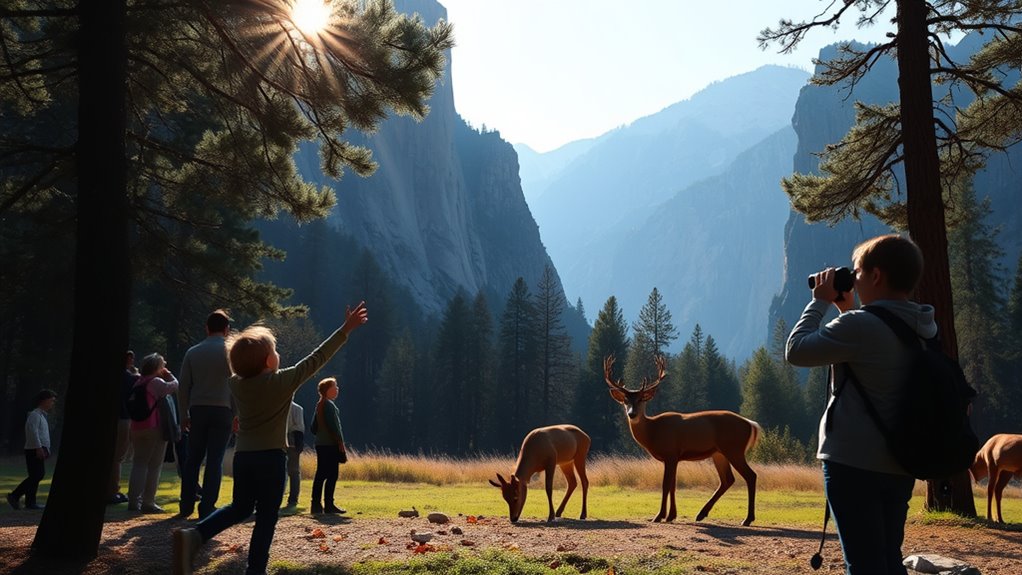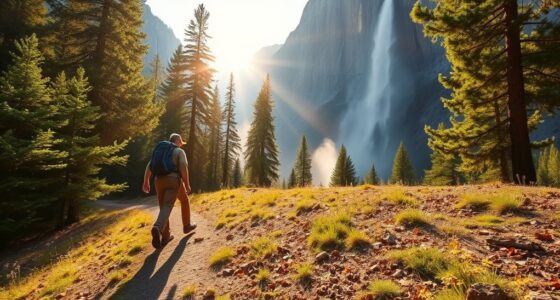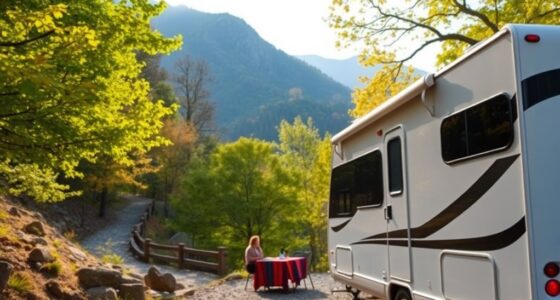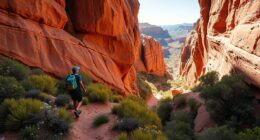When you’re in Yosemite National Park, it’s essential to respect wildlife viewing etiquette. Keep a safe distance—100 yards from bears and wolves, 25 yards from other animals. Never feed wildlife; it disrupts their natural behavior and can lead to dangerous situations. Use binoculars for a closer look without bothering them. Always observe animal behavior and back away if they seem agitated. Following these guidelines not only protects you but also contributes to the well-being of Yosemite’s wildlife. Discover more tips on preserving these precious encounters.
Key Takeaways
- Never feed wildlife, as it disrupts their natural behaviors and can lead to dangerous encounters.
- Maintain a distance of at least 100 yards from bears and wolves, and 25 yards from other wildlife.
- Use binoculars or zoom lenses to observe animals without getting too close.
- Be aware of animal behavior; back away slowly if they appear agitated or stressed.
- Follow park guidelines to protect both wildlife and the natural environment for future visitors.

When you venture into Yosemite National Park, you’ll likely encounter a diverse array of wildlife, from deer grazing in meadows to bears rummaging through the forest. Observing these magnificent creatures can be an exhilarating experience, but it’s crucial to remember that you’re a visitor in their home. Practicing proper wildlife viewing etiquette is essential to ensure both your safety and the well-being of the animals you encounter.
One of the most important rules is to never feed wildlife. It might be tempting to toss a snack to a curious raccoon or a chipmunk, but feeding animals disrupts their natural behaviors. When you feed wildlife, they become reliant on human food sources, which can lead to malnutrition and dangerous encounters with people. Instead of providing food, consider bringing a camera to capture moments from a safe distance. This way, you can enjoy the beauty of these animals without compromising their health or safety.
Never feed wildlife; it disrupts their natural behaviors and can lead to dangerous encounters. Enjoy them from a safe distance instead.
Maintaining distance is another critical aspect of wildlife viewing. Always keep a respectful space between you and the animals. Approaching too closely can stress them out and provoke defensive behavior, especially in larger animals like bears or moose. The National Park Service recommends staying at least 100 yards away from bears and wolves and at least 25 yards away from all other animals. Use binoculars or a zoom lens to get a closer look without intruding on their space.
You should also be aware of your surroundings and the behavior of the animals. If you notice an animal acting unusually or appearing agitated, it’s best to back away slowly and quietly. Loud noises and sudden movements can startle wildlife, leading to unpredictable reactions. Remember, you’re in their territory, and they have their own set of rules. Understanding wildlife behavior can help you make safer choices while observing animals.
Lastly, always follow park guidelines and regulations concerning wildlife. These rules are in place to protect both visitors and animals. By respecting these guidelines, you contribute to the preservation of Yosemite’s natural beauty and help maintain a healthy ecosystem.
Frequently Asked Questions
Can I Bring My Pet While Viewing Wildlife in Yosemite?
You can’t bring your pet while viewing wildlife in Yosemite. For pet safety, it’s vital to keep them away from wild animals and their habitats. Yosemite has strict leash regulations, requiring pets to be on a leash no longer than six feet in developed areas. However, many trails and areas are off-limits to pets, so it’s best to check the park’s guidelines before planning your visit. Prioritize the safety of both your pet and local wildlife!
What Should I Do if I Encounter an Aggressive Animal?
If you encounter an aggressive animal, stay calm and back away slowly without turning your back. Keep an eye on its behavior and avoid sudden movements. Make certain you’re maintaining a safe distance—don’t approach it. Use any safety precautions you’ve learned, like making noise to assert your presence, but don’t shout. If the situation escalates, seek shelter in a vehicle or building. Always prioritize your safety and respect the animal’s space.
Are Drones Allowed for Wildlife Photography in the Park?
Imagine capturing nature’s beauty without causing disruption. Unfortunately, you can’t use drones for wildlife photography in the park. Strict drone regulations are in place to prevent wildlife disturbance, ensuring animals aren’t stressed by buzzing machines. If you want stunning shots, consider hiking to scenic viewpoints or using your camera from afar. This way, you respect both the environment and its inhabitants while still creating unforgettable memories of your adventure.
Is There a Best Time of Year for Wildlife Viewing?
Yes, there’s a best time of year for wildlife viewing. Spring and early summer are ideal, as animals are more active during this season, especially with seasonal migration. You’ll likely see deer and bears as they emerge from hibernation and search for food. Fall also offers peak activity, with animals preparing for winter. Planning your visits during these times increases your chances of spotting diverse wildlife, making your experience unforgettable.
Can I Feed Wildlife in Yosemite National Park?
No, you can’t feed wildlife in Yosemite National Park. Feeding animals disrupts their natural behavior and can lead to dangerous wildlife interactions. It might seem harmless, but it can cause animals to become reliant on human food, which isn’t healthy for them. Enjoy observing wildlife from a distance instead. Remember, keeping wildlife wild is essential for their safety and yours, so stick to your snacks and let the animals find their natural food.
Conclusion
In Yosemite, you’re not just a spectator; you’re part of nature’s grand performance. By respecting wildlife and their space, you help guarantee that everyone can enjoy the show for years to come. So, let’s tiptoe around their homes, keep our distance, and cherish each encounter as a fleeting gift. Remember, the best way to enjoy these beautiful creatures is to let them be, allowing you to savor the wonder of their world in peace.










